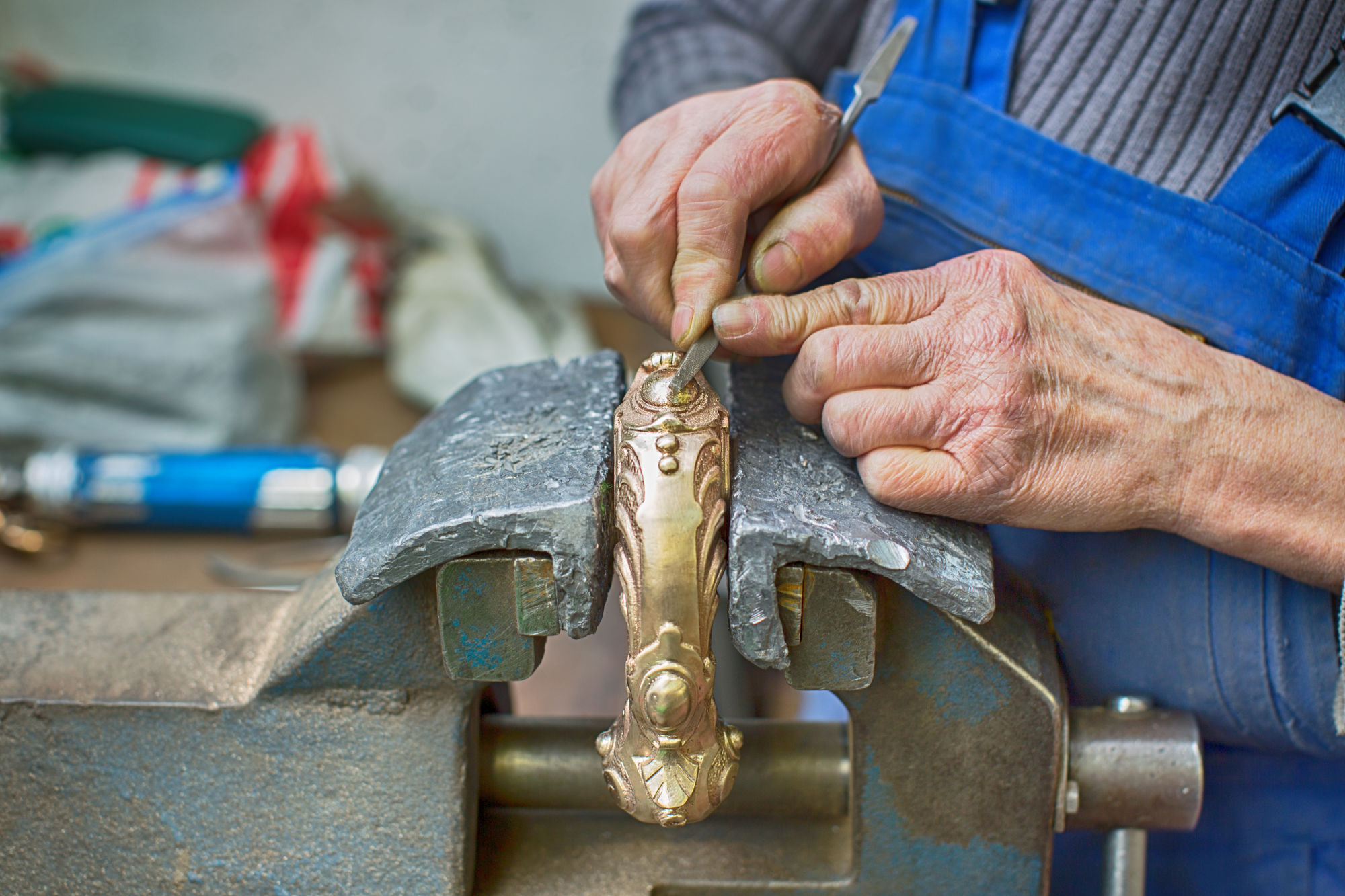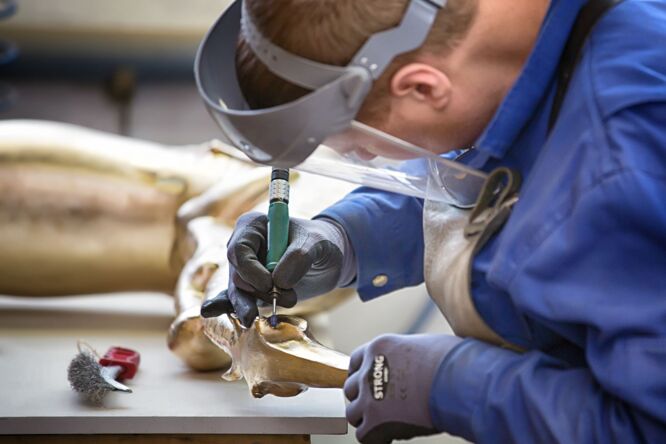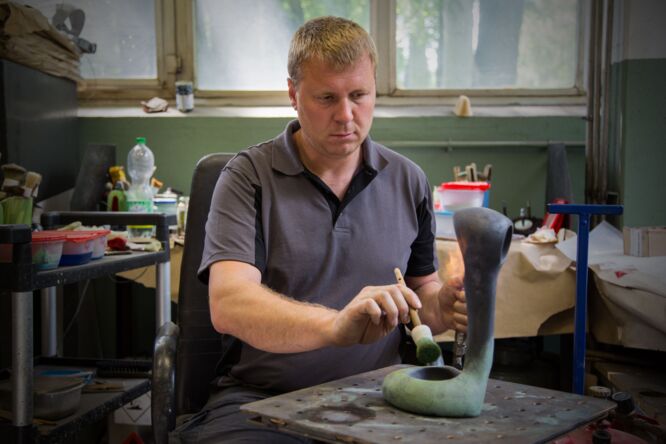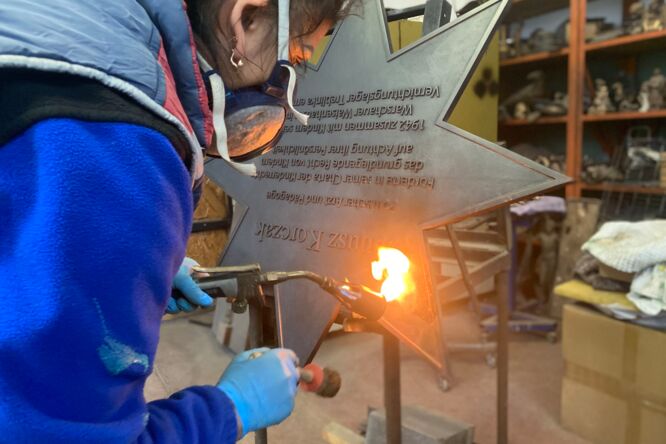Chiselling, patinating and finishing
Welcome to the world of fine craftsmanship!
Cast objects are fascinating works of craftsmanship. The casting work is only the first step - the real magic happens in the finishing and refinement to give the cast objects an unrivalled aesthetic.
Whether it is a commercial casting or an artistic masterpiece, finishing plays a crucial role in improving the final result. They serve not only to eliminate imperfections, but also to emphasise the individual character of the object. Skilful techniques and choice of materials can transform a cast object into an incomparable work of art.
History and importance
The art of chiselling and patinating has a long and rich history dating back to ancient times. Even in the advanced civilisations of ancient Egypt and Mesopotamia, metals were chased and patinated to create valuable artefacts and pieces of jewellery. Over the centuries, these techniques have evolved and were popular in different cultures and eras.
In ancient Greece, for example, elaborate reliefs were created using chasing techniques on metal vessels and armour. These masterful works often depicted mythological motifs and symbolised the high craftsmanship of the time. A notable example of this is the so-called "Warrior Vase", a Greek amphora from the 6th century BC, which is decorated with detailed chiselled scenes of warriors fighting.
Chiselling and patination also flourished during the Renaissance. Artists such as Benvenuto Cellini, a famous Italian goldsmith and sculptor, used these techniques to create exquisite pieces of jewellery and sculptures. Cellini's most famous work is his bronze statue of Perseus with the head of Medusa, which displays incredible detail and vibrancy with sophisticated chiselling.
Over the centuries, many other artists and craftsmen have successfully applied these techniques of their time. From the intricately chiselled watches of French master Pierre Jaquet Droz to the artfully patinated sculptures of modern sculptor Anish Kapoor, chasing and patination are synonymous with timeless quality and creative expression.
Today, the tradition of chiselling and patination lives on, while modern craftsmen combine these ancient techniques with contemporary materials and design concepts. The works of art created through these processes are a tribute to the artisan tradition and brighten our homes and lives with their beauty.
Reworking after casting
Chiselling
Chiselling is one of the oldest craft techniques, in which metal is shaped and decorated by precise beating, grinding, scraping and polishing on a soft surface. Our experienced craftsmen are masters of the art of chiselling and can create shapes and patterns in the metal with every stroke. Whether filigree decorations on a piece of jewellery, important details on a sculpture or artistic reliefs on an antique piece of furniture - chasing brings out fine nuances, enhances character and expression, eliminates casting defects and thus lends each piece an unmistakable beauty.
Tools for chiselling
Patinating
Patination is a technique in which the metal is given a beautiful aged patina through targeted chemical or artificial ageing processes. This patina changes the surface of the metal and gives it an antique or vintage look. Our specialists always keep an eye on the right balance between ageing and protecting the material in order to achieve the best possible result. Whether it's an authentic patinated façade or an elegant bronze sculpture, patination creates a timeless yet individual appearance.
Tools for patinating
Materials for chiselling and patinating
Chiselling and patination is often carried out with precious metals such as gold, silver, bronze or copper. These metals are characterised by their flexibility and adaptability, which enables craftsmen to create complex designs.
Various workpieces such as jewellery, cutlery, decorative objects, sculptures or architectural elements can be chased and patinated. Depending on the area in which the craft is applied, different materials can be used.
The correct use of tools and materials requires a deep understanding and years of experience. Our craftsmen are true masters in their field and have mastered the art of chiselling and patinating to perfection. With their skilful craftsmanship and selection of high-quality tools and materials, they create unique, artistic masterpieces that delight our customers.
We are proud of our traditional and innovative craftsmanship techniques, and we use high-quality tools and materials. This ensures that every piece that leaves our workshop is of the highest quality and mesmerising beauty.
Further refinements
Examples of cast objects that have unfolded their true radiance through refinement
Bronze sculptures
Bronze sculptures have a long tradition and are a popular cast object. These sculptures can be brought to life by grinding, polishing and patinating. The finest details and structures are worked out to create a breathtaking work of art.
Jewellery
Cast objects are often also used to make jewellery. Simple castings can be turned into unique and individual pieces of jewellery through finishing work such as smoothing surfaces or incorporating elements such as gemstones or enamel.
Door fittings
Cast objects are often used for the production of door fittings such as door knobs, door handles or door plates. Finishing techniques such as engraving, gilding or enamelling can turn these door fittings into real eye-catchers and improve the overall aesthetics of a door or entrance.
Lamps and luminaires
Cast objects can also be used to make lamps and luminaires. By reworking them, such as attaching lampshades or adding details such as decorative embellishments or patinations, these lamps can become true works of art and influence the ambience of a room.
The finishing and refinement of cast objects is a true art form that raises the aesthetics and quality of the objects to a new level. From grinding and polishing to the removal of casting seams, chasing, patinating, surface treatments and coatings - each technique requires expertise, skill and passion. Craftsmen and artists play a crucial role in the design and finishing of cast objects to create unique masterpieces that fascinate and inspire viewers. Through the correct application of the appropriate techniques and attention to detail, cast objects can become timeless treasures that captivate and move their viewers.



